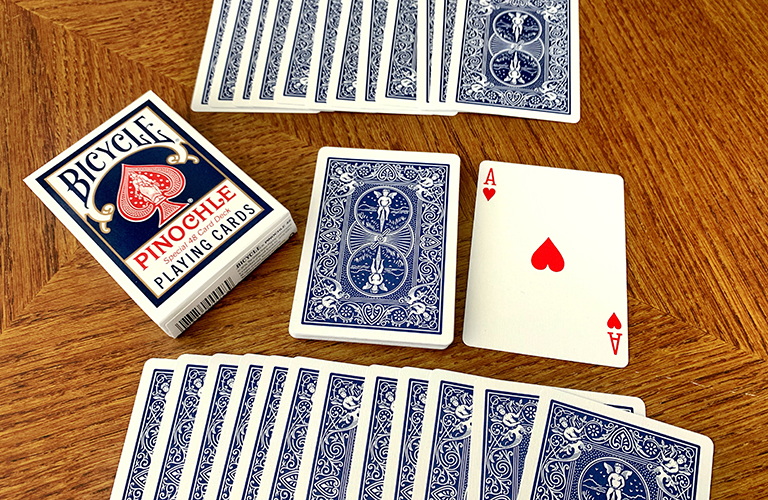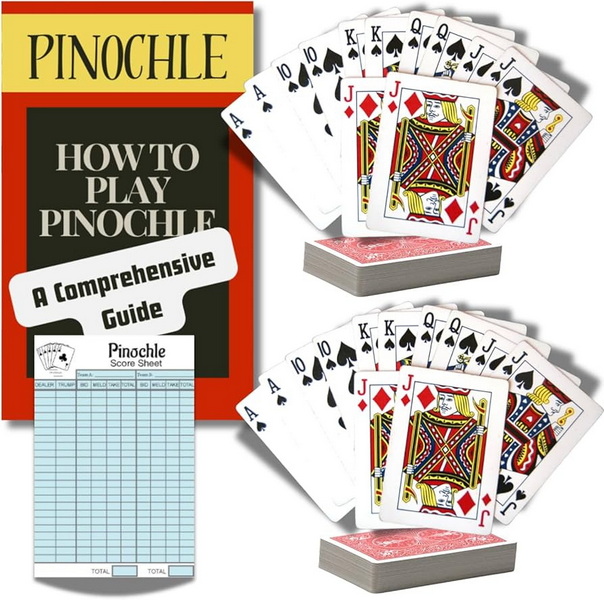Content Menu
● Overview of Pinochle
● Game Setup
● Phases of the Game
>> Bidding
>> Melding
>> Trick-Taking
● Scoring Points
● Strategies for Success
● Common Variants
● Tips for New Players
● Conclusion
● Related Questions
>> 1. What is the objective of Pinochle?
>> 2. How many players can play Pinochle?
>> 3. What are some common melds in Pinochle?
>> 4. How do you score points in Pinochle?
>> 5. What happens if no one bids in Pinochle?
● Citations:
Pinochle is a classic card game that combines elements of strategy, teamwork, and skill, making it a favorite among card enthusiasts. This article will explore the rules, gameplay mechanics, strategies, and nuances of Pinochle, ensuring you have a comprehensive understanding of how to play this engaging game.

Overview of Pinochle
Pinochle is typically played with four players in two partnerships, although variations exist for three players or even two. The game uses a 48-card deck consisting of two sets of cards from 9s to Aces in each suit. The objective is to score points through melding combinations of cards and winning tricks.
Game Setup
1. Players: Pinochle is usually played with four players in two teams.
2. Deck: A standard Pinochle deck consists of 48 cards, including two sets of Aces, Kings, Queens, Jacks, 10s, and 9s.
3. Dealing: Each player is dealt 12 cards in sets of three. The remaining cards form the stockpile.
4. Trump Suit: After dealing, the top card of the stockpile is turned face up to determine the trump suit for that round.
Phases of the Game
Pinochle consists of several key phases:
Bidding
- After the cards are dealt, players evaluate their hands and begin bidding.
- The player to the dealer's left starts by making a bid or passing.
- Bidding continues clockwise until three consecutive players pass.
- The highest bidder becomes the declarer and names the trump suit.
Bidding is a critical phase because it sets the tone for how aggressive or conservative your play will be throughout the round. Players must balance their desire to win the bid with the strength of their hand. A strong hand with high meld potential should prompt a higher bid, while a weaker hand may necessitate passing.
Melding
- Players reveal specific combinations of cards (melds) that score points.
- Common melds include:
- *Marriages*: King and Queen of the same suit (4 points).
- *Runs*: A sequence of cards in the same suit (10 points for A-10).
- *Pinochle*: The Queen of Spades and Jack of Diamonds (40 points).
Melding is not only about scoring points but also about revealing information to your partner while keeping your opponents guessing. Players should be strategic about what melds they declare to maximize their team's score while minimizing what opponents can infer about their hands.
Trick-Taking
- The non-dealer leads the first trick by playing any card.
- Players must follow suit if possible; if not, they may play a trump card or any other card.
- The highest card in the lead suit or the highest trump wins the trick.
- Players draw cards from the stock after each trick to maintain a hand of 12 cards.
Trick-taking requires keen observation and memory skills. Keeping track of which cards have been played can provide valuable insights into what your opponents might hold. Additionally, knowing when to play your high-value cards versus when to save them for later tricks can be crucial in securing victory.
Scoring Points
Points are scored in two ways: through melding and trick-taking.
- Melding Points: Points are awarded based on the melds declared at the beginning.
- Trick Points: Each Ace is worth 11 points, each Ten is worth 10 points, Kings are worth 4 points, Queens are worth 3 points, Jacks are worth 2 points, and taking the last trick earns an additional 10 points.
The game continues until one team reaches a predetermined score (commonly 1,500 points). Understanding how to maximize both melding and trick-taking scores is essential for success in Pinochle.
Strategies for Success
To excel at Pinochle, players should consider various strategies:
- Effective Communication: Partners should develop signals to convey information about their hands without explicitly stating it. This can enhance teamwork and strategy execution.
- Meld Management: Prioritize high-value melds while also considering potential future melds based on drawn cards. For example, if you have several high-ranking cards in one suit but lack a marriage, consider how you might draw into that combination as play continues.
- Card Counting: Keep track of cards played to gauge what remains in play. This knowledge can inform your decisions during trick-taking. For instance, if you know that many high trumps have already been played, you may feel more confident leading with lower-value cards.
- Bidding Wisely: Assess your hand carefully before bidding. If you have strong melds or high cards, it may be worth bidding higher; otherwise, passing can be prudent. Remember that bidding too aggressively can lead to disappointment if your hand does not pan out as expected.
- Defensive Play: If you are on defense during trick-taking (i.e., your partner is not leading), consider playing lower-value cards unless you are confident you can win with a higher card. This conserves your strong cards for later tricks when they may be more impactful.

Common Variants
Pinochle has several popular variants:
- Cutthroat Pinochle: Played with three players individually rather than in partnerships. This variant alters strategies significantly since players must fend for themselves without partner support.
- Double Pinochle: Involves using a 64-card deck that includes additional ranks (8s and 7s). This variant increases complexity and scoring opportunities but also requires players to adapt their strategies accordingly.
Tips for New Players
For those new to Pinochle or looking to improve their gameplay experience:
- Practice Regularly: Like any card game, practice helps improve your skills and understanding of strategies over time.
- Watch Experienced Players: Observing seasoned players can provide insights into advanced strategies and techniques that may not be immediately apparent to novices.
- Stay Patient: Pinochle can be complex; don't rush through decisions or get discouraged by initial losses. Take time to analyze each game afterward for lessons learned.
Conclusion
Pinochle is a captivating card game that blends strategy with social interaction. Whether you're playing casually or competitively, understanding its rules and strategies can enhance your enjoyment and success in the game. With practice and experience, you'll find yourself mastering this classic pastime while enjoying quality time with friends and family.

Related Questions
1. What is the objective of Pinochle?
The objective is to score points through melding combinations of cards and winning tricks during gameplay.
2. How many players can play Pinochle?
Pinochle can be played with two to four players, with variations available for different player counts.
3. What are some common melds in Pinochle?
Common melds include marriages (King and Queen of the same suit), runs (A-K-Q-J-10 in one suit), and Pinochles (Queen of Spades and Jack of Diamonds).
4. How do you score points in Pinochle?
Points are scored through melding specific card combinations and winning tricks based on card values during gameplay.
5. What happens if no one bids in Pinochle?
If all players pass during bidding, that hand is annulled, and the next player deals again.
Citations:
[1] https://www.pinochle-palace.com/how-to-play-pinochle/
[2] https://www.mplgames.com/blog/pinochle-card-game/
[3] https://vipspades.com/blog/pinochle-rules-learn-how-to-play-pinochle/
[4] https://www.mplgames.com/blog/how-to-play-pinochle/
[5] https://playingcarddecks.com/blogs/how-to-play/pinochle-game-rules
[6] https://www.pinochle.net/partners-pinochle-with-4-card-pass-basic-winning-strategies/
[7] https://www.britannica.com/topic/pinochle
[8] https://pinochlebyfletcher.wordpress.com/about/beginners-guide-to-four-handed-pinochle-simplified/
[9] https://bicyclecards.com/how-to-play/pinochle-2
































